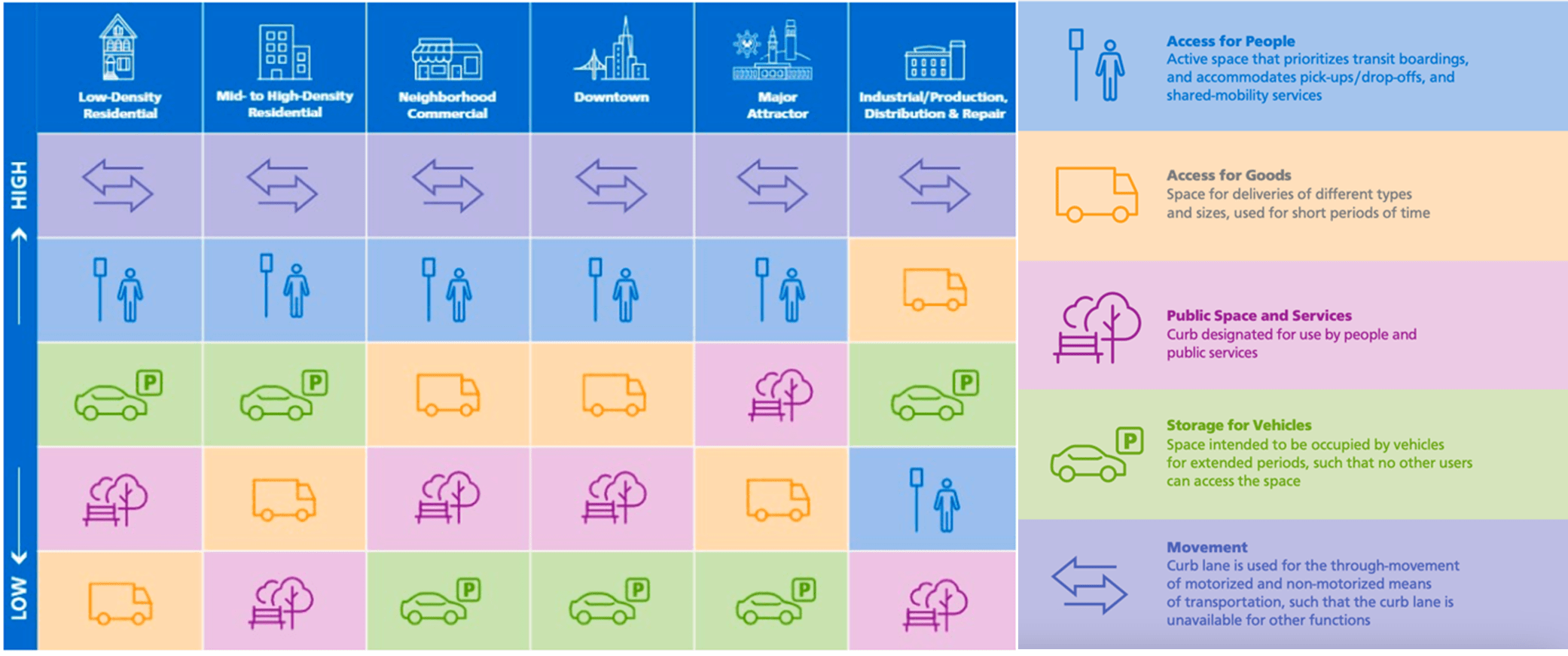(Do Not) Curb the Enthusiasm
Dynamic curbside management could help solve current and future mobility issues. But what is it? And how can it be implemented?
European cities and regions are facing increasing demands for the mobility of people, goods, and services. Historically, these mobility demands were satisfied by expanding capacity, but now, cities need to operate within specific boundaries due to the lack of space and climate obligations: this results in a need for innovations that allow them to make more optimal use of space to satisfy the increasing mobility demands.
The increasing demand for mobility leads to increasing demand for curbside access. The curb is the place where a function shift happens between the transporting function and the activities of the street, where the people, goods, and services stop moving and generate value for the city. The limited amount of curb space available for one transport system leads to conflicts regarding the allocation of space among different users and uses — this can negatively impact a city's economic productivity and livability.
Moreover, additional innovative functions are presenting themselves in this limited space due to new mobility services models, such as ride-hailing and e-scooters, and the competition for space spreads like wildfire. The conflicts occurring at the curbside are not unique to high-traffic volume city centres but also occur in the calmer areas.
What is Dynamic Curbside Management?
Dynamic curbside management is a strategy where the allocation of curbside functions is tailor-made based on the needs of the users. The demands for the curbside can change during the day, week, month, or season, and the curbside functions will change accordingly to these demands minimizing the conflicts at the curbside. When implementing a dynamic curbside management approach, it is important to understand that there is no one shoe fits all strategy. A strategy will differ from city to city and might even differ from street to street and needs to be shaped to the means available for the local authorities.
One of the approaches that could be taken to prioritise the function of the street to determine strategy and measures is shown in the image below.

Curb’s function prioritized by land use in San Francisco. Credit: SFMTA, San Francisco
The model creates a hierarchy of functions based on the street type where the curb function needs to be changed. The benefit of using such a model is that there is a structural method for determining the curb function.

The Publican’s sidewalk and parklet seating on Windsor Road. Credit: Quackenbush
Based on this model, a wide variety of interventions can be implemented such as parklets, dock(less) shared bicycle locations and bicycle corrals, greenery and function-altering parking locations. Each comes with its own set of benefits and challenges.
The instalment of a parklet — a public seating platform that turns curbside parking spaces into a vibrant community space — can increase revenues by up to 20/30%, having more significant economic benefits for the city than a traditional parking space. However, while being a seasonal measure (primarily a spring and summer one) that could be implemented in various street types, a parklet may not be as effective or relevant in a residential area.
How can local authorities effectively implement Dynamic Curbside Management?
The successful implementation of a dynamic curbside strategy is related to two components: the eight steps proposed by EIT Urban Mobility (2021) and the five pillars of dynamic curbside management implementation.
Eight steps
One of the approaches that could be taken to prioritise the function of the street to determine strategy and measures is shown in the following list. Indeed, when a city is assessing and implementing a dynamic curbside it is recommended to take the following eight steps into account:
1. Get to know the streets: what is their purpose?
2. Anticipate the impact of shifting the curb
3. Make room for emerging mobility modes
4. Create a team that flexibly manages the diverse and in-real-time demands of the curb
5. Standardise encoded info about curb use
6. Rethink the curb as a flexible space and plan accordingly
7. Manage the curb dynamically
8. Monitor overall transport activity
Five pillars
Alongside the eight steps, the following five pillars should be considered by local authorities for the successful implementation of dynamic curbside management.

The five pillars of dynamic curbside management implementation. Credit: Mitchell Neels - Layout revisited by Alessia Giorgiutti
To ensure the successful implementation of any dynamic curbside intervention, enforceability via local regulations must be a key consideration. Moreover, an effective, integrated dynamic curbside management requires collaboration among all departments through institutional arrangements.
The successful management and involvement of stakeholders are both crucial for any strategy related to the curbside, which is a busy and complex public space with numerous stakeholders involved.
Implemented technologies and digital services already play an essential role in enabling a dynamic curbside and this will only become truer in the coming years; however, when approaching the theme of technology, local authorities must make a distinction between roadside technology expectations and end users' expectations.
Lastly, the competition for curb space is a significant challenge for both cities and local authorities, with the physical street being where the theoretical curbside strategy must be put into action.
Intense collaboration with various cities showed that the development of a successful curbside strategy requires the synergy of the previously mentioned pillars. Local authorities seemed eager to implement something innovative but were unable to realise this by challenges occurring in one or multiple of these pillars. A correct organisation in these pillars is recommended before initiating a new dynamic curbside strategy.
Conclusion
Effective curbside management is becoming increasingly important as cities continue to grow and face new challenges. In this report, we have explored the complex nature of curbside management, including the various stakeholders involved, the need for local solutions as well as standardised approaches, and the importance of integrating technology and data analysis. We have also discussed the four key pillars of successful curbside management: local regulations, institutional arrangements, stakeholder involvement, and implemented technologies and digital services.
Based on these insights, we have identified there are three key takeaways that can help cities develop effective curbside management strategies:
- Dynamic curbside management matters: Dynamic curbside management is an important tool that needs to be implemented to plan for the mobility challenges of the future.
- Cities should put their money where their mouth is: Cities should invest in their overall 'readiness' for the implementation of dynamic curbside management. By improving overall readiness, a city enables communication to service providers about the conflicts that need to be solved and the infrastructure that can be utilised to achieve this.
- Implementation with no evaluation means nothing: Further research is executed on the successful implementation of a dynamic curbside management strategy. If you deploy such strategies yourself: reserve resources for evaluation and impact assessment, taking into account the five pillars for successful strategies.
Click here to read the article in its original format.
About the author:
Mitchell Neels is a Junior Mobility Consultant at LuxMobility. His work activities entail the development of sustainable urban mobility plans (SUMPs) and the development of sustainable airport mobility plans in European-funded projects.

